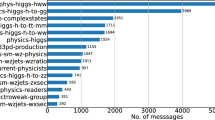Abstract
A method that uses an e-mail exchange log we developed is described that evaluates the communication patterns within a project. A frequency map enables the strength of communication to be measured among members, and inner vector analysis enables clear understanding of the exact position of members directly displaying the relationships among members. Experimental analysis of a real project within an organization confirmed the effectiveness of the method, and communication patterns were clearly represented. Our method is unique in that communication patterns within a project can be identified computationally only by using the e-mail exchange log.
Preview
Unable to display preview. Download preview PDF.
Similar content being viewed by others
References
Fujikawa, H., et al.: Density - based high speed mass - mail detection technique and its evaluation. IPSJ 2004(55), 1–6 (2004)
Graham, P.: Better bayesian filtering. In: Proc. of the 2003 spam Conference (2003)
Zhang, T., Oles, F.J.: Text Categorization based on regularized linear classification methods. Information Retrieval 4, 5–31 (2001)
Murakami, A., Nagao, K., Takeda, K.: Discussion Mining: Knowledge Discovery from Online Discussion Records. In: Proc. of the NLPRS, Workshop on NLP and XML, pp. 31–38 (2001)
Murakami, A.: Chance discovery from an/the electronic mail –Information technology report of chance discovery, TDU, pp. 210–223 (2003)
Nakamura, F., Mizuta, H.: Evaluation by communication of enterprise organization. IPSJ 45(9), 950–955 (2004)
Mizuta, H., Nakamura, F.: Enterprise Organization and Communication Network. IPSJ, SIG-ICS 136, 163–168 (2004)
Igata, N., Tsuda, H., Watanabe, I., Matsui, K.: Semantic Groupware: An approach to KNOW-WHO using RDF. In: SANKEN-6th (ISIR) International Symposium (Poster), March 11, Japan (2003)
Bonacich, P., Lloyd, P.: Eigenvector-like measures of centrality for asymmetric relations. Social Networks 23(3), 191–201(11) (2001)
Freeman, L.C.: http://eclectic.ss.uci.edu/~lin/pubs.html
Author information
Authors and Affiliations
Editor information
Rights and permissions
Copyright information
© 2007 Springer-Verlag Berlin Heidelberg
About this paper
Cite this paper
Noda, J., Saga, R., Tsuji, H. (2007). Project Evaluation by E-Mail Communication Pattern. In: Jacko, J.A. (eds) Human-Computer Interaction. HCI Applications and Services. HCI 2007. Lecture Notes in Computer Science, vol 4553. Springer, Berlin, Heidelberg. https://doi.org/10.1007/978-3-540-73111-5_79
Download citation
DOI: https://doi.org/10.1007/978-3-540-73111-5_79
Publisher Name: Springer, Berlin, Heidelberg
Print ISBN: 978-3-540-73109-2
Online ISBN: 978-3-540-73111-5
eBook Packages: Computer ScienceComputer Science (R0)




